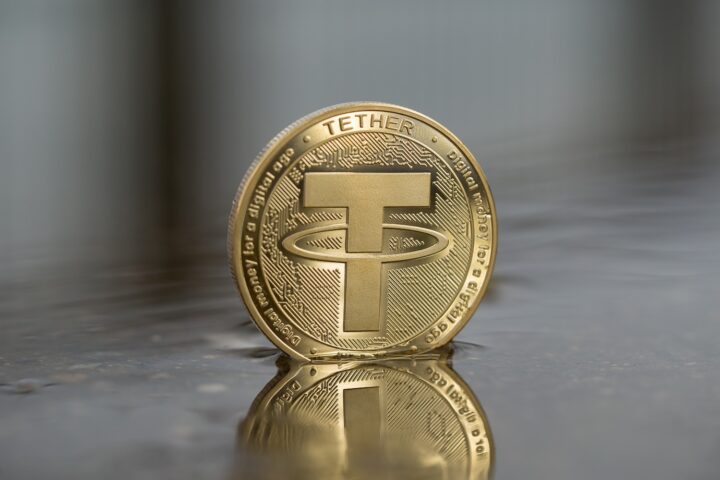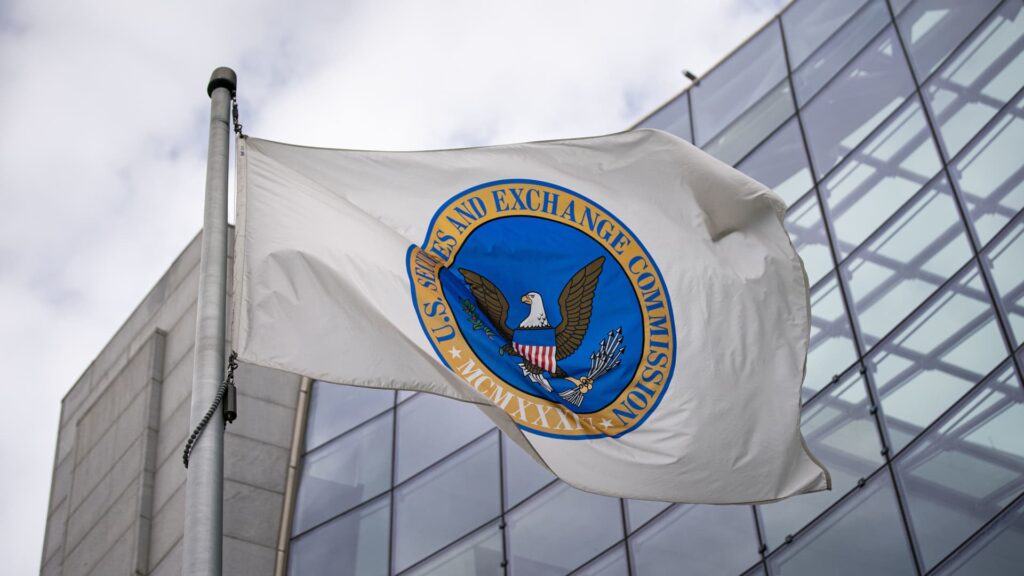VanEck has agreed to pay a £1.75 million fine to settle charges brought by the United States Securities and Exchange Commission (SEC) regarding its launch of a social media-focused exchange-traded fund (ETF) in 2021.
The SEC imposed a civil penalty on the investment adviser.
On February 16, the SEC disclosed in a statement that during the launch of the VanEck Social Sentiment ETF in March 2021, VanEck did not fully disclose the involvement of a prominent social media personality in marketing the product.
The ETF aimed to track an index using “positive insights” from social media and other data sources.
However, the SEC found that VanEck attempted to enhance the fund’s success through social media and collaborated with an influential and divisive online personality to increase its appeal.
Although the financial watchdog did not explicitly name the influencer, reports from 2021 had previously linked David Portnoy, founder of Barstool Sports, to the promotion of the VanEck ETF.
The regulator observed an undisclosed detail: the influencer’s fee was tied to the fund’s growth, ensuring higher compensation as the fund expanded.
The SEC criticised the undisclosed agreement, focusing on VanEck’s failure to inform the ETF’s board about the influencer’s intended involvement.
This undisclosed arrangement had significant implications for the management contract and fund operations, breaching the board’s duty to oversee financial aspects during advisory contract discussions.
Andrew Dean, co-chief of the SEC Enforcement Division’s Asset Management Unit, emphasised the importance of transparency from advisers.
READ MORE: Coin Metrics Research: Nation-States Unable to Destroy Bitcoin and Ethereum Networks
He noted that the failure to provide accurate disclosures hampers the board’s ability to properly assess the advisory contract and understand the economic impact of licensing agreements.
VanEck accepted the SEC’s order acknowledging its violation of the Investment Company Act and Investment Advisers Act.
The company agreed to a cease and desist order, censure, and the required financial penalty without admitting or denying the findings.
The announcement comes after the company’s decision to terminate one of its ETF products, the Bitcoin Strategy ETF, a month ago following a comprehensive performance evaluation.
In an apparent effort to boost the popularity of its dedicated spot Bitcoin ETF with the ticker HODL, VanEck indicated on February 15 that it would reduce its fees from 0.25% to 0.20% starting February 21.
Bitcoin exchange-traded funds (ETFs) have experienced another robust week, with net inflows surpassing £2.2 billion from Feb. 12–16.
According to Bloomberg analyst Eric Balchunas, the combined volume exceeded the inflows received by any other among the 3,400 ETFs available in the United States.
BlackRock’s iShares Bitcoin Trust (IBIT) attracted the majority of capital, accumulating positive flows of £1.6 billion over the week, as per data from BitMEX Research.
“£IBIT alone has taken in £5.2b YTD, which is 50% of BlackRock’s total net ETF flows, out of 417 ETFs,” noted Balchunas.
Among the spot Bitcoin ETFs holding billions of pounds in assets, Fidelity’s Wise Origin Bitcoin Fund witnessed significant inflows, drawing £648.5 million over the last five trading sessions.
The Ark 21Shares Bitcoin ETF secured £405 million during the same period, while the Bitwise Bitcoin ETF attracted £232.1 million in capital inflows.
However, outflows from the Grayscale Bitcoin Trust are affecting the collective performance of the other recently approved spot Bitcoin ETFs.
READ MORE: Bitcoin Hash Rate Expected to Drop by Up to 20% Post Halving, Analysts Predict
The fund experienced £624 million in withdrawals from Feb. 12–16 as investors continued to divest.
Since its transition from an over-the-counter product to a spot ETF on Jan. 10, Grayscale’s fund has seen over £7 billion in capital outflows.
The new ETFs are believed to be one of the factors propelling Bitcoin’s recent price surges.
The cryptocurrency has surged 91% in the past four months, buoyed by market sentiment surrounding the approval of spot Bitcoin ETFs by the U.S. Securities and Exchange Commission (SEC) on Jan. 10.
During the week, Bitcoin gained nearly 7% and is trading at £51,434 at the time of writing, marking a 24% increase in February.
Major banks and financial institutions are also taking note of the new ETFs.
In a Feb. 14 letter, a trade group coalition representing Wall Street’s largest firms urged the SEC to consider modifications to the Staff Accounting Bulletin 121, which offers guidance on accounting for crypto asset custody obligations.
The proposed revision would permit banks to serve as custodians of the BTC funds.
Bitcoin mining difficulty, which gauges the level of complexity in solving the intricate cryptographic puzzles integral to the mining process, surpassed 80 trillion on Friday, February 16th.
As per BTC.com, the network’s hash rate, indicating the cumulative computational power utilised by miners, achieved 562.81 exahashes per second (EH/s), with the mining difficulty reaching a peak of 81.73 trillion.
The escalation in Bitcoin (BTC) mining difficulty has been consistent since January 2023, with forecasts anticipating a climb to 100 trillion in the imminent months.
In Bitcoin’s proof-of-work consensus mechanism, heightened difficulty necessitates miners to employ greater computational power and energy to uncover the correct hash.
Over the past year, Bitcoin’s difficulty level has more than doubled.
During its automatic readjustment on February 15th, Bitcoin mining difficulty was slated to surge by an estimated 6%.
If this transpires, data from monitoring resource BTC.com suggests it will propel the difficulty to unprecedented heights above 80 trillion for the first time.
On February 16th, Bitcoin maintained a value of $52,000 at the commencement of Wall Street trading, buoyed by the revelation of surpassing expectations in the latest United States macro data.
READ MORE: Bakkt Secures Regulatory Approval to Raise $150 Million Amid Financial Concerns
Figures from Cointelegraph Markets Pro and TradingView depicted a stagnant BTC price performance as the week’s final TradFi trading session unfolded.
In April, Bitcoin’s mining rewards are set to halve in what is termed the Bitcoin Halving.
As a hedge against inflation, Bitcoin’s developers integrated this reduction into the token’s structure approximately every four years, with the previous halving transpiring in May 2020.
The forthcoming halving will diminish Bitcoin’s rewards from 6.25 BTC to 3.125 BTC.
This adjustment may lead to a reduced hash rate, with less efficient miners grappling to cover expenses and potentially shutting down their mining rigs.
Consequently, a diminished hash rate is likely to precipitate a decline in Bitcoin mining difficulty as the network endeavours to sustain a consistent block production rate every 10 minutes.
Analysts from Galaxy Digital speculate that as much as 20% of Bitcoin’s existing hash rate could deactivate post the Bitcoin halving, leaving only the most efficient mining rigs operational.
Major banks and financial institutions in the United States are urging the United States Securities and Exchange Commission (SEC) to revise its definition of crypto assets, potentially enabling them to assume a more significant role in the crypto sphere, such as serving as custodians for the recently sanctioned spot Bitcoin exchange-traded funds.
On 14th February, a coalition of trade groups including the Bank Policy Institute, American Bankers Association, Financial Services Forum, and Securities Industry and Financial Markets Association presented their argument in a letter to SEC Chair Gary Gensler.
The coalition highlighted the recent endorsement of spot Bitcoin (BTC) exchange-traded products in the U.S., observing the absence of American banks as custodians for the approved products.
“The Commission recently approved 11 Spot Bitcoin ETPs, allowing investors access to this asset class through a regulated product.
However, notably absent from those approved products are banking organizations serving as the asset custodian, a role they regularly play for most other ETPs.”
The letter called for the SEC to consider adjustments to Staff Accounting Bulletin 121 (SAB 121), issued in March 2022, which offers guidance on accounting for crypto asset custody obligations.
They noted that it has been two years since the issuance of the guidance, and there have been “several relevant developments” during this period, including the approval of spot Bitcoin ETFs.
The existing guidance mandates banks to include crypto assets on their balance sheet, resulting in increased costs and hindrances to offering crypto custody services on a large scale.
READ MORE: Genesis Granted Approval to Liquidate £1.3 Billion in Grayscale Bitcoin Trust Shares
The coalition has now urged the SEC to refine the definition of crypto assets in SAB 121 to exclude traditional assets recorded on the blockchain.
This would prevent assets like tokenized deposits from falling under the stringent crypto guidelines.
They also seek exemptions for banks from the on-balance sheet requirements while retaining the disclosure obligations, enabling them to engage in certain crypto activities while maintaining transparency for investors.
In a post on X, Bitwise chief investment officer Matt Hougan stated that the letter indicates a change in the “tone around crypto regulation in Washington,” with others suggesting that banks are expressing interest in joining the “digital finance wave.”
“US banks, left off key bitcoin ETF roles, are pushing SEC to tweak guidance around holding digital assets,” summarised Bloomberg ETF analyst Eric Balchunas.
Meanwhile, TheBitcoin Therapist, author of a weekly Bitcoin newsletter, echoed the sentiment:
“Bankers are getting annoyed they can’t hold spot Bitcoin ETFs for their customers. The Q1 FOMO is already driving them mad.”
According to preliminary data from Farside, total aggregate inflows to the recently launched spot Bitcoin ETFs have just surpassed $4 billion despite an acceleration in outflows from Grayscale.
Up to 20% of Bitcoin’s present hash rate may cease operation following the Bitcoin halving, as block rewards diminish and only the most efficient mining rigs persist.
Towards the conclusion of 2023, approximately 70% of the Bitcoin hash rate stemmed from eight ASIC miner models, as indicated by Galaxy’s mining analysts in a report dated February 14, citing Coin Metrics data.
“Given how sensitive the breakevens are for the various ASIC models to Bitcoin price and transaction fees as a percent of rewards, we estimate that between 15 – 20% of network hash rate coming from the ASIC models […] could come offline,” the analysts articulated.
Galaxy’s forecast considered potential future power costs.
It computed the breakeven threshold for mining rig models based on “post-halving economics,” with each mined Bitcoin block slated to halve rewards from 6.25 BTC to 3.125 BTC, “transaction fees constituting 15% of rewards and a Bitcoin price of $45,000.”
According to Galaxy’s more conservative projections, nearly all outdated mining rigs — particularly Bitmain’s S9, Canaan’s A1066, and MicroBT’s M32 models — would be decommissioned, while about half of MicroBT M20S and Bitmain S17 models would persist online.
These five models collectively accounted for roughly 15% of Bitcoin’s hash rate by the end of 2023.
READ MORE: BONK Memecoin Surges 7% Amidst Revolut Partnership Rumors
Enduring predominantly would be the Antminer S19 and S19J Pro, newer and more prevalent models that comprised over half of Bitcoin’s hash rate in 2023, alongside Canaan’s A1246, albeit a minor fraction of each might still deactivate in locales with elevated operational expenses.
Nevertheless, a bleaker scenario would witness almost all older models nearing complete deactivation, although Galaxy once more anticipates that Canaan’s A1246 and both S19 models might endure.
Galaxy’s analysts acknowledged that their estimates could be influenced by certain business choices.
Miners utilising “older and more inefficient machines” are likely to implement bespoke firmware to enhance their rig’s efficiency and yield, whilst certain miner models may transition to miners with more economical power costs instead of shutting down.
The analysts also speculated that miners employing the newer S19 models might struggle to maintain profitability, and those employing older mining rigs might purchase them as an upgrade.
The Bitcoin halving will be enacted at block number 840,000, anticipated to be mined around April 20, according to data from Blockchair.
Submit a Cointelegraph PR
Bitcoin remained steady at $52,000 during the Wall Street opening on February 16, with the latest United States macro data surpassing expectations.
Data from Cointelegraph Markets Pro and TradingView indicated a lack of movement in BTC price leading into the final TradFi trading session of the week.
Following closely after the Consumer Price Index (CPI) release two days earlier, the Producer Price Index (PPI) figures for January added to concerns about inflation in the U.S.§§§
Year-on-year, PPI stood at 0.9%, slightly lower than the previous month but still 0.3% higher than market forecasts.
In combination with the high CPI, these results made markets more cautious about the possibility of the Federal Reserve adjusting fiscal policy this year.
According to data from CME Group’s FedWatch Tool, the likelihood of the Fed reducing interest rates at its March meeting was 8.5% at the time of reporting — less than half the 17.5% probability at the beginning of the week.
“A March interest rate cut is likely completely ruled out after this data,” trading resource The Kobeissi Letter commented on X (formerly Twitter), echoing its response to CPI.
“Furthermore, a May rate cut has become questionable as well.”
Bitcoin reached $52,884 on Bitstamp the previous day, marking its highest level since late November 2021, but encountered resistance from sellers.
Analysing four-hour timeframes, popular trader Skew highlighted the importance of the 21-period exponential moving average (EMA), currently at approximately $51,000.
READ MORE: Breaking: Crypto Websites Promote Innovative Uniswap Scam
“There’s been choppy price action here with a lot of inside bar closes essentially within the same intraday balance,” he observed.
U.S. spot-Bitcoin exchange-traded funds (ETFs) experienced net inflows of nearly half a billion dollars on February 15.
This contributed to an impressive week where the ETF products gained renewed interest more than a month after their initial launch.
However, despite removing more BTC from circulation than adding to it daily, the ETFs have caused some concern among market observers.
In his latest analysis, Venturefounder, a contributor at on-chain analytics platform CryptoQuant, suggested that a slowdown in ETF interest could expose Bitcoin to a significant retracement.
“Bitcoin ETF net inflow flatline/normalize is where the next 20-30% correction will start,” part of X’s commentary stated alongside a summary of current flows.
A previous post outlined potential BTC price floor levels, with estimates extending down to $34,000.
According to the latest research from crypto intelligence firm Coin Metrics, it is no longer feasible for nation-states to dismantle the Bitcoin and Ethereum networks via 51% attacks due to the exorbitant costs involved.
A 51% attack occurs when a malicious actor possesses over 51% of the mining hash rate in a proof-of-work system or 51% of staked crypto in a proof-of-stake network.
This power could be abused to manipulate the blockchain, compromising trust.
In a report released on February 15, Coin Metrics researchers Lucas Nuzzi, Kyle Waters, and Matias Andrade contended that nation-state attackers can no longer sustain such assaults due to the prevailing cost of capital and operational expenses needed to attain 51% control.
The researchers introduced a metric named “Total Cost to Attack” (TCA) to precisely gauge the expense of launching an attack on a blockchain network.
Utilising TCA, the report concluded that there are no financially rewarding avenues to attack either the Bitcoin or Ethereum networks, negating the financial incentive for malicious actors.
“In none of the hypothesized attacks presented here [would the attacker] be able to profit by attacking Bitcoin or Ethereum,” read the report.
READ MORE: Bitcoin Price Prediction 2024 and 2025
“Consider that even in the most profitable double spend scenario presented, where the attacker could potentially make $1B after spending $40B, that would account for a 2.5% rate of return.”
Analysing secondary market data and real-time hash rate output, the report revealed that a 51% attack on Bitcoin would necessitate an actor to procure a staggering 7 million ASIC mining rigs, costing approximately $20 billion.
Acknowledging the scarcity of available ASIC rigs, the report explored an alternative attack vector, which might be pursued by a particularly “relentless” actor.
Assuming a nation-state attacker could fabricate their own mining rigs—identifying the Bitmain AntMiner S9 as the only “plausible” device for reverse-engineering—it would still exceed a $20 billion investment.
Furthermore, the report debunked concerns over a potential 34% staking attack from Lido validators on Ethereum, suggesting it would be both time-consuming and financially prohibitive.
Castle Island Ventures partner Nic Carter commended Coin Metric’s research as “enormously important,” highlighting its rigorous empirical analysis as a significant contribution to the literature.
A bankruptcy adjudicator has granted Genesis Global Holdco permission to liquidate approximately £1.3 billion worth of Grayscale Bitcoin Trust (GBTC) shares as part of endeavours to reimburse investors.
During a hearing on 14th February at the United States District Court for the Southern District of New York, conducted via Zoom, Judge Sean Lane endorsed an order allowing Genesis to divest a portion of its investments from Grayscale.
Documents filed in February indicated that Genesis held about £1.6 billion worth of shares in GBTC, Grayscale Ethereum Trust (ETHE), and Grayscale Ethereum Classic Trust (ETCG).
According to Genesis’s bankruptcy filings, it claimed to possess around 35 million GBTC shares and 11 million ETHE and ETCG shares.
Grayscale lodged a restricted objection to the proposal for the company to liquidate the trust assets on 9th February, asserting that the sales were “subject to written approval” by the investment firm but did not aim to “delay, impede, or obstruct the Debtors’ sale or transfer of Trust Assets.”
READ MORE: SOL Token Surges, Overtakes BNB to Claim Fourth Spot in Cryptocurrency Rankings
On 10th January, the U.S. Securities and Exchange Commission (SEC) sanctioned the conversion of Grayscale’s GBTC to a spot Bitcoin exchange-traded fund for listing and trading on U.S. exchanges, alongside offerings from 10 other asset managers.
Genesis remarked that the SEC’s approval would ease the redemption of shares in cash.
Genesis disclosed a £21 million settlement with the SEC on 31st January over its purported involvement in offering and vending unregistered securities through the Gemini Earn program.
The company operates independently from Genesis Global Trading, which encountered enforcement proceedings initiated by the New York Department of Financial Services in January.
Shares in cryptocurrency exchange Coinbase have surged by 37% in the past week, riding the wave of a recent upswing in Bitcoin prices.
Analysts anticipate robust performance as the company prepares to unveil its fourth-quarter results on Thursday.
MarketWatch and FactSet’s aggregated data reveals a consensus among analysts, foreseeing a substantial revenue increase for Coinbase in Q4.
Projections suggest a rise of approximately 22% from Q3, reaching $825 million.
The surge in revenue is expected to be fuelled by heightened trading volumes.
Analysts estimate a near doubling from $76 billion in Q3 to $142.7 billion in Q4.
Coinbase is also expected to report a fourth-quarter earnings-per-share of $0.02, marking a turnaround from the $0.01 loss per share reported in the preceding quarter.
This surge coincides with Bitcoin’s price rise of 16.3% over the past week, as reported by Coinmarketcap.
On February 13, competitor Robinhood announced a 24% year-on-year increase in Q4 revenue, driven in part by a surge in cryptocurrency trading revenue, which amounted to $43 million, up 10% year-on-year.
READ MORE: SOL Token Surges, Overtakes BNB to Claim Fourth Spot in Cryptocurrency Rankings
Despite these positive indicators, some remain cautious about Coinbase’s future performance in 2024.
JPMorgan analysts, in a note to investors on January 22, predicted a decline in Coinbase’s share price, citing concerns about the lacklustre performance of spot Bitcoin ETFs trading.
However, recent data indicates an uptick in Bitcoin ETF flows, with BlackRock’s IBIT alone generating $493 million in inflows on February 13.
Coinbase, serving as custodian for eight of the top 10 spot Bitcoin ETF providers, including BlackRock and iShares, stands to benefit from this resurgence.
The ongoing lawsuit with the United States Securities and Exchange Commission (SEC) poses another challenge for Coinbase.
Nevertheless, crypto lawyer James Murphy, also known as “MetaLawMan,” remains optimistic about Coinbase’s prospects, expressing confidence that the SEC will lose the case.
Coinbase shares are currently up 14% for the day, buoyed by a broader rally in the cryptocurrency sector, highlighted by Bitcoin’s surge above $50,000 on February 13.
Gold-tracking exchange-traded funds (ETFs) in 2024 have witnessed significant outflows, amounting to billions, in stark contrast to ETFs tracking the spot price of Bitcoin.
As per an X post from Bloomberg intelligence analyst Eric Balchunas on Feb. 14, the foremost gold ETFs have encountered outflows totaling $2.4 billion thus far in 2024.
Only three among them have experienced marginal inflows this year: VanEck Merk Gold Shares, FT Vest Gold Strategy Target Income ETF, and Proshares UltraShort Gold.
Notably, the most substantial outflows emanated from BlackRock’s iShares Gold Trust Micro and iShares Gold Trust, with $230.4 million and $423.6 million exiting, respectively.
Conversely, the ten sanctioned spot Bitcoin ETFs have garnered cumulative inflows of $3.89 billion and registered unprecedented volume since their inception on Jan. 11, according to preliminary data from Farside.
Commenting on the trend, portfolio manager Bitcoin Munger remarked, “Not only is Bitcoin sucking up funds, but gold is hemorrhaging AUM at an alarming rate across many ETFs.”
Balchunas, however, opined that the migration of gold ETF investors to Bitcoin ETFs wasn’t necessarily prevalent, suggesting it could be attributed to “US equity FOMO” instead.
Bitcoin pioneer Jameson Lopp shared a chart comparing the performance of the two ETFs, raising questions about the stance of gold investor and Bitcoin detractor Peter Schiff.
READ MORE: HectorDAO Investors Demand Control Amidst $2.7 Million Hack Scandal
The disparity has been exacerbated by the decline in gold prices throughout 2024. The precious metal has depreciated by 3.4% since the year’s commencement, reaching a two-month low of $1,993 per ounce on Feb. 14.
Meanwhile, Bitcoin prices have surged by 23.5% over the same period, hitting a two-year high of $52,483 on Feb. 14.
In a report released earlier in February, the World Gold Council highlighted global gold ETF outflows and a “reduction in speculative positioning” as significant factors contributing to gold’s subdued performance.
It also noted that “Long-term Treasuries and the US dollar, on the back of strong upside US economic surprises, were also headwinds.”
While Bloomberg senior commodity strategist Mike McGlone had previously forecasted gold outperforming Bitcoin in 2024, current observations suggest otherwise.
Bitcoin and gold, often compared for their shared store of value attributes, have historically been favoured investments during economic and geopolitical uncertainties.









